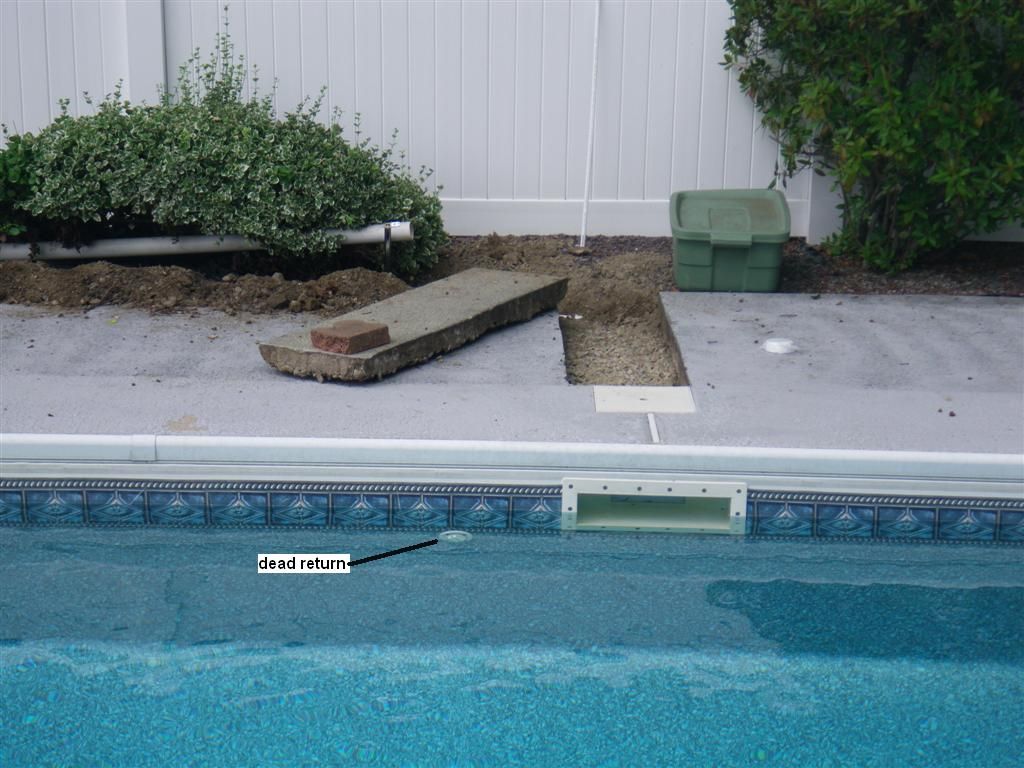I have a 27k gallon IG pool. I have a skimmer, main drain and 3 returns. Here is a diagram:

I have a plugged-in dead return. Near skimmer. It's about a foot away and slightly below the skimmer (ignore construction, it was another story long time ago):

At some point I checked it and it seems like it was leaking. I was bored another day and put together a L shape pvc pipe contraption, screwed it to the return socket and poured some water into it and it seems like it's holding the level just fine. I have few terminated lines near my equipment pad and I assume one of them is connected to this return. Before I do pressure testing and connect it to the pump/filter I would like to better understand the net result on water circulation and mixing.
On one hand I will have 4 points of water injection that should help with mixing. On other hand the overall velocity at the return jets will decrease even though the overall water flow increase will counter that to some extend. So I believe in general it will help with the mixing and circulation. Having 4 returns on high speed doesn't sound like a problem. But I wonder if the exit velocity on slow speed speed will be too low and it would make things worse?
Right now I have 3/4" eyeballs on my returns, but I have 1/2" ones as well. I guess worst case scenario I could go with smaller eyeballs and have things as they are right now, but with 4 injection points instead of 3.
I would point that return towards the main drain since it's right next to the skimmer. Pipes are 1.5" all around
Right now my filter pressure is about 8.75psi and vacuum is about 6 in the pump's wet end. Overall head is 38ft and flow is about 55 GPM (calculated and measured). I assume on low speed the flow is half of it.

I have a plugged-in dead return. Near skimmer. It's about a foot away and slightly below the skimmer (ignore construction, it was another story long time ago):

At some point I checked it and it seems like it was leaking. I was bored another day and put together a L shape pvc pipe contraption, screwed it to the return socket and poured some water into it and it seems like it's holding the level just fine. I have few terminated lines near my equipment pad and I assume one of them is connected to this return. Before I do pressure testing and connect it to the pump/filter I would like to better understand the net result on water circulation and mixing.
On one hand I will have 4 points of water injection that should help with mixing. On other hand the overall velocity at the return jets will decrease even though the overall water flow increase will counter that to some extend. So I believe in general it will help with the mixing and circulation. Having 4 returns on high speed doesn't sound like a problem. But I wonder if the exit velocity on slow speed speed will be too low and it would make things worse?
Right now I have 3/4" eyeballs on my returns, but I have 1/2" ones as well. I guess worst case scenario I could go with smaller eyeballs and have things as they are right now, but with 4 injection points instead of 3.
I would point that return towards the main drain since it's right next to the skimmer. Pipes are 1.5" all around
Right now my filter pressure is about 8.75psi and vacuum is about 6 in the pump's wet end. Overall head is 38ft and flow is about 55 GPM (calculated and measured). I assume on low speed the flow is half of it.

